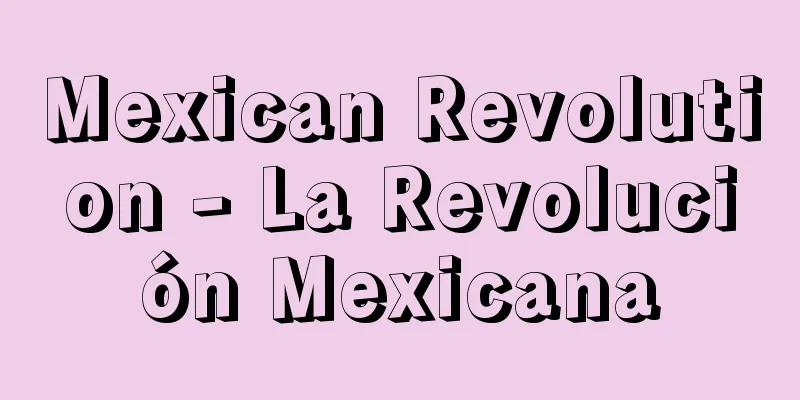Mexican Revolution - La Revolución Mexicana

|
A Mexican nationalist revolution that took place between 1910 and 1920. It aimed to restore democratic politics by overthrowing the Diaz dictatorship (1876-1911), which represented the interests of foreign capital and the large landlord class, and at the same time to reform the dependent and undemocratic socio-economic structure. From around 1900, the democratization movement by middle-class intellectuals intensified, and especially from 1905 onwards, they engaged in armed struggle and bloody strikes influenced by it continued. In the autumn of 1910, Madero, who had fled to the United States in opposition to Diaz's reelection, declared armed struggle, and with the cooperation of Villa, who was from a poor peasant family in the north, and Zapata, who was from a farming family in the south, he succeeded in overthrowing Diaz in May of the following year. However, Madero, who was from one of Mexico's leading landowners and ethnic capitalists, showed a negative attitude towards socio-economic reform, especially land reform, so in November of the same year, Zapata announced the Ayala Plan, which demanded thorough land reform, and defected from the Madero government. Taking advantage of this division of the revolutionary forces, General Huerta succeeded in a counter-revolutionary coup in February 1913, and Madero was massacred. In response, Carranza, a major landowner in the northeast, declared the resumption of the revolution and led the Constitutional Revolutionary Army, which included the troops of wealthy farmer Obregon in the northwest and Villa in the north-central region, to the south, while the Zapata faction also applied pressure from the south. Furthermore, with the intervention of the new US President Wilson, who condemned the counter-revolutionary coup, Huerta went into exile in July 1914. However, the revolutionaries split into the Carranza-Obregon faction, which represented the upper and middle classes, and the Villa-Zapata faction, which represented the lower peasants, and civil war broke out for the third time. At first, the latter faction was dominant, but Obregon persuaded the conservative Carranza and promised land reform and improvements to the status of workers, winning over the peasants and workers. He launched a counterattack in the spring of 1915, and won a major victory over Villa's army in April and May of the same year. The new constitution enacted in February 1917 detailed the fact that land, water, and underground resources should belong to the state and the people, that private ownership could be restricted for the public interest, and that agrarian reform should be promoted, and also paved the way for the nationalization of oil, mines, railways, and other assets owned by foreign capital. It also enumerated the rights of workers and made it clear that the state should intervene in labor-management issues. President Carranza, who was elected based on the new constitution, was passive about reforms, suppressed the labor movement, and continued to oppress the peasant army, including assassinating Zapata. In 1920, Obregón gained power and made peace with the Zapata and Villa factions, ending a decade of civil war, but fundamental reforms had to await the late 1930s. [Takashi Noda] "The Mexican Revolution" by Yoshiro Masuda (Chuko Shinsho) [References] |Source: Shogakukan Encyclopedia Nipponica About Encyclopedia Nipponica Information | Legend |
|
1910~20年に起きたメキシコの民族主義革命。外国資本と大地主階級の利益を代弁するディアス独裁(1876~1911)を打倒して民主政治を回復し、あわせて従属的・非民主的社会経済構造の変革を目ざした。1900年ごろから中産階級知識人による民主化運動が強まり、とくに05年以後は彼らによる武装闘争と、その影響を受けた流血ストが続いた。10年秋、ディアス再選に反対してアメリカに亡命していたマデロが武装闘争を宣言、北部貧農出身のビリャや南部農民出身のサパタなどの協力を得て、翌11年5月ディアス打倒に成功した。しかし、メキシコ有数の大地主=民族資本家の一族であったマデロは、社会経済改革、とりわけ土地改革に消極的な姿勢を示したため、同年11月サパタは徹底した土地改革を要求するアヤラ・プランを発表してマデロ政府に離反した。このような革命勢力の分裂を利用して、13年2月ウエルタ将軍が反革命クーデターに成功しマデロは虐殺された。これに対し北東部の大地主カランサが革命再開を宣言、北西部の富農オブレゴンや北中部のビリャの軍も加わった立憲革命軍を率いて南下し、南からはサパタ派も圧力を加えた。さらに反革命クーデターを非難するアメリカの新大統領ウィルソンの介入もあって、14年7月ウエルタは亡命した。 しかし、革命派は上流階級や中産階級を代表するカランサ‐オブレゴン派と、下層農民を代表するビリャ‐サパタ派に分裂し、三たび内戦となった。初めは後者が優勢だったが、オブレゴンは保守的なカランサを説得して土地改革や労働者の地位改善を約束し農民や労働者を味方につけ、1915年春から反撃を開始、同年4~5月にはビリャ軍に大勝した。17年2月に制定された新憲法には、土地、水、地下資源などは本来、国家、国民に所属すべきこと、公共の利益のために私的所有権は制限されうること、農地改革を推進すべきことなどが詳細に記され、外国資本所有の石油、鉱山、鉄道などの国有化にも道を開いた。労働者の諸権利が列挙され労使問題に国家が介入すべきことも明記された。新憲法に基づいて選ばれたカランサ大統領は改革には消極的で、労働運動を抑圧し、サパタを暗殺するなど農民軍への弾圧も続けた。20年オブレゴンが権力を獲得し、サパタ派やビリャ派との和平が成立し、10年に及ぶ内戦は終わったが、根本的改革は30年代後半を待たねばならなかった。 [野田 隆] 『増田義郎著『メキシコ革命』(中公新書)』 [参照項目] |出典 小学館 日本大百科全書(ニッポニカ)日本大百科全書(ニッポニカ)について 情報 | 凡例 |
<<: Mexican Intervention - Mexican Intervention
>>: Mexico City (English spelling)
Recommend
Kattegat Strait - Kattegat
The sea area between Denmark and Sweden in Northe...
Annual salary - nenkyuu
Abbreviation for Nenryokyubun. It refers to the a...
Gatekeeper - Kidoban
During the Edo period, guards were appointed to g...
Declaratory judgment - Feststellungsurteil
A judgment that determines the existence or non-ex...
Domestic Relations Mediation
A procedure aimed at resolving disputes in family...
ALARA - Alara
" as low as reasonably achievable " is a...
Cleft lip - Shinretsu
Also known as a tricuspid lip, harelip, or cleft l...
Asano Family Company - Asano Dodoku Kaisha
...It can be said to be an industrial conglomerat...
Jesuit
…It was founded in the 16th century by Ignatius o...
Cho - Cho
[1] 〘 noun 〙① A type of tax under the Ritsuryo sys...
Fanatics - Fanatics
…Inspired by the spread of Lutheranism, a more ra...
Twilight - Hakumei
After sunset and before sunrise, a period of twil...
al-Nuwira, al-Hādī (English spelling) alNuwiraalHadi
...Official name = Republic of Tunisia al-Jumhūrī...
Tahiti [island] - Tahiti
The central island of French Polynesia. Located in...
Aioicho - Omachi
...A city in the southwest of Hyogo Prefecture, f...







![Urayasu [city] - Urayasu](/upload/images/67cb01297cb13.webp)

![Kudzu [Hot Spring] - Kudzu](/upload/images/67cb687d441c5.webp)